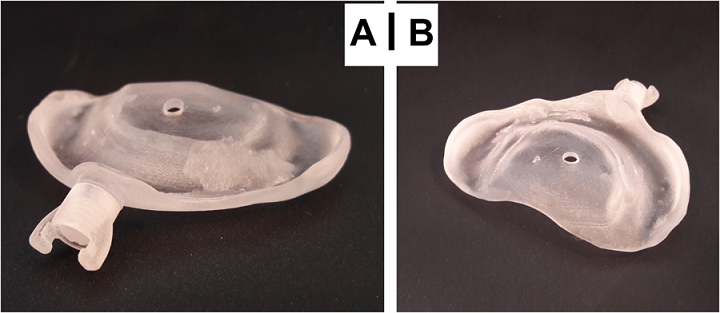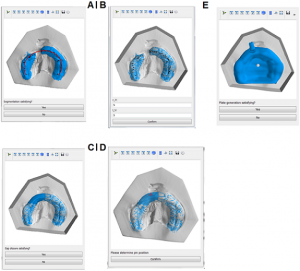 It’s scary to think about newborn babies undergoing surgeries and other medical procedures, but 3D printing has come into play several times to help make these successful. Now, the technology is being used again to help newborns with cleft lip and palates (CLP) in a new study conducted by the Technical University of Munich (TUM).
It’s scary to think about newborn babies undergoing surgeries and other medical procedures, but 3D printing has come into play several times to help make these successful. Now, the technology is being used again to help newborns with cleft lip and palates (CLP) in a new study conducted by the Technical University of Munich (TUM).
According to the study, nasoalveolar molding (NAM) is a “presurgical orthofacial treatment modality” for newborns afflicted with CLP. The method uses a plastic plate to reshape an infant’s gums, nostrils, and lip before undergoing the actual CLP surgery. The plate is inserted and adjusted according to the child’s alveolar development, and then a nasal stent is used to extend the plate during treatment. The technique is considered complete once the primary surgical closure of the lip is performed.
While NAM does work, the treatment is lengthy, with many weekly adjustments; it also requires that several impressions be taken when the baby needs new plates, and the treatment modality is only offered in special centers. However, by introducing CAD/CAM technology and 3D printing into the NAM treatment, the amount of impression-taking, along with the cost of the treatment, can be decreased, and the production modality is better facilitated.
A team of researchers based at TUM recently published a paper, titled “A semi-automated virtual workflow solution for the design and production of intraoral molding plates using additive manufacturing: the first clinical results of a pilot-study,” in the Nature journal.
Graphical User Interface for the design of RapidNAM devices. (A) Automated detection of alveolar crest. (B) Selection of bridging area. (C) Gap closure. (D) Pin positioning. (E) Virtual plate.
The abstract reads, “Computer-aided design and computer-aided manufacturing (CAD/CAM) technology has been implemented in the treatment of cleft lip and palates (CLP) by several research groups. This pilot study presents a technique that combines intraoral molding with a semi-automated plate generation and 3D-printing. The clinical results of two intraoral molding approaches are compared. This is the first clinical investigation of semi-automated intraoral molding. Our study included newborns with unilateral CLP. Plaster models were digitalized and measured by two independent observers. Two methods of CAD/CAM-assisted intraoral molding were compared: (i) stepwise manual design of molding plates (conventional CAD/CAM-intraoral molding) and (ii) a semi-automated approach with an automated detection of alveolar ridges (called RapidNAM) assisted by a graphical user interface (GUI). Both approaches significantly narrowed the clefts and resulted in a harmonic alveolar crest alignment. The GUI was easy to use and generated intraoral molding devices within minutes. The presented design solution is an efficient technical refinement with good clinical results. The semi-automated plate generation with a feasible GUI is fast but allows individual adaptations. This promising technique might facilitate and foster the more widespread use of CAD/CAM-technology in intraoral molding therapy.”
In their study, the researchers described their virtual workflow, and also analyzed how effective semi-automated intraoral molding plate generation, or RapidNAM, is for helping to treat CLP.
“Healthy newborns with unilateral CLP (n = 14) were included in the study,” the researchers wrote in their paper. “Two groups were formed: one group was treated with conventional CAD/CAM-intraoral molding plates as published previously with digitally designed intraoral molding plates serving as a reference group and the other group with RapidNAM-plates. In both groups, impressions were taken from the upper jaw within the first few days of life and at the end of molding therapy when primary lip closure was performed at the age of approximately 3–4 months.”
A 3D triangulation scanner from 3Shape in Denmark was used to digitalize the casts, and after creating a graphical user interface (GUI), an algorithm automatically detected the alveolar ridge, in order to find the monthly growth rate in the anatomical study of 32 healthy newborn babies. Special 3D software was used to help with plate expansions during the manual plate molding.
The study concludes, “RapidNAM overcomes previous limitations of conventional CAD/CAM-intraoral molding plates by its semi-automated workflow. The GUI creates a series of molding plates within a few minutes but still allows changes by the user. The resulting plates are as adaptable as conventional NAM-devices. The algorithm automatically detects the edentulous alveolar ridges and may also have further dental applications. RapidNAM gives good clinical results and may bring nasoalveolar molding to a broader practice.”
Co-authors are Florian D. Grill, Lucas M. Ritschl, Franz X. Bauer, Andrea Rau with the Friedrich Alexander Universität Erlangen-Nürnberg, Dominik Gau, Maximilian Roth, Markus Eblenkamp, Klaus-Dietrich Wolff, and Denys J. Loeffelbein.
Discuss this story and other 3D printing topics at 3DPrintBoard.com or share your thoughts below.
Subscribe to Our Email Newsletter
Stay up-to-date on all the latest news from the 3D printing industry and receive information and offers from third party vendors.
You May Also Like
Further Understanding of 3D Printing Design at ADDITIV Design World
ADDITIV is back once again! This time, the virtual platform for additive manufacturing will be holding the first-ever edition of ADDITIV Design World on May 23rd from 9:00 AM –...
3D Printer Maker EVO-tech Reborn as NEVO3D — Once More With Feeling
EVO-tech was a 3D printing service and original equipment manufacturer established in 2013 and based in Schörfling am Attersee, Austria. The company produced high-quality material extrusion systems featuring linear bearings,...
3D Systems Brings 3D Printed PEEK Cranial Implant to the U.S. with FDA Clearance
For more than 10 years, 3D Systems (NYSE:DDD) has worked hand-in-hand with surgeons to plan over 150,000 patient-specific cases, and develop more than two million instruments and implants from its...
CDFAM Returns to Berlin for Second Annual Symposium
The second CDFAM Computational Design Symposium is scheduled for May 7-8, 2024, in Berlin, and will convene leading experts in computational design across all scales. Building upon the first event...


































